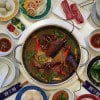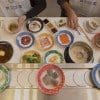The words “Lobster Tom Yum” were on a board outside a nondescript concrete building, which looked like no other in Chinatown.
There was no comfortingly gaudy, red and gold façade, no monster plastic-fronted menu with pictures of what was on offer and there wasn’t a dragon in sight – just an indecipherable menu card with strange pictograms by the front door.
The words “Lobster Tom Yum” were on a board outside a nondescript concrete building, which looked like no other in Chinatown. There was no comfortingly gaudy, red and gold façade, no monster plastic-fronted menu with pictures of what was on offer and there wasn’t a dragon in sight – just an indecipherable menu card with strange pictograms by the front door.
Peering through the windows revealed a line of people with their backs to us, seated in front of large pans – each emitting clouds of steam rising to the tall ceiling. Through the steam, little bowls could just be seen snaking in front of the people. Attendants in black shirts with more pictograms on their backs were watching the seated people intently.
A shiver ran down my spine. Uncertain of what I was seeing, Orwellian thoughts flooded my mind. My companion pushed me through the door. “Welcome to Shuang Shuang” said a smiling member of staff. “Come, sit. You will like our hot pot.”
Inside was a revelation. Shuang Shuang (Chinese slang for ‘feeling good, with a bit of oh yeah!’, I’m unreliably informed) has a bright, modern interior with, on first sight, a combination of fondue stations and a Yo Sushi style conveyor belt winding its way around the restaurant in front of the seated diners.
If you’ve been anywhere in China or East Asia in the last 1,000 years, you’ll probably have eaten hot pot. Typically, it’s a communal eating arrangement where families or groups of friends sit round a large table and dunk bite sized, raw ingredients into a boiling broth in the centre before transferring them to their bowl, dipping them into a sauce and downing in one.
Shuang Shuang has updated the concept. “Hot Pot in Motion”, they call it. The majority of the restaurant is more suited to couples than groups, since you sit in long lines in front of the raised conveyor belt – although they have what they call booths (tables, to you and I) on the first floor that can seat four.
Between each couple is a large empty bowl sunk into the table top whilst in front of you is an array of bowls, chopsticks, tongs, spoons and a strainer.
Our looks of confusion drew the attention of a waiter who explained we first needed to choose our broths (each bowl is split in two) into which we would plunge our own ingredients to cook them. They offer 5 varieties including a vegetarian broth. We tried three and settled on Tom Yum which, based on shell fish, sounded ideal for the lobster but was too spicy for me. To accompany it we chose Black Bird, made from chicken and wolfberries, which had a sweet tang.
While our broths were prepared we chose pigs ears and scallop & prawn fritters as starters. Both were delicious although the Xinjiang sauce was a bit spicy on the ears – the pig’s, not mine. The broths were poured into our bowl and the little induction hot plate turned to max to get it hot enough for us to go to work.
Next we had to choose, or create our own, dipping sauces – more work apparently. The waiter explained that after we had cooked our food we would want to dip it into a sauce before eating it. I must have looked hopeful at the mention of actually eating something since the waiter smiled at that point and indicated the choices of ingredients passing on the conveyor barely an arm’s length away.
We were advised on cooking times for the ingredients – between one and five minutes – and provided with an egg timer to assist with this, although only a few of the timings he mentioned were actually marked on the glass containing the sand. I was too embarrassed or perhaps just too hungry to mention I had already forgotten all his timings anyway. I certainly didn’t notice the cooking times were printed on the little cover to each ingredient.
My companion and I looked at one another and reached for plates off the conveyor – I wasn’t going to wait for the lobster to come round and just chose something which looked like prawn balls plus some flat noodles. My companion chose mixed choi plus glass vermicelli. The bowls of broth were bubbling nicely. Well they were until we dropped our ingredients into them, of course. “Do you think we start timing them now or wait for the bowl to bubble again”, I queried. I didn’t wait for a reply and turned the egg timer over.
It struck me that the likelihood of me cooking each ingredient correctly was pretty low since I didn’t take all the noodles out after they were cooked but just enough to fit the little bowl into which I dipped my chopsticks. The remaining noodles carried on cooking. I looked around and other diners didn’t seem bothered and we were the only ones provided with an egg timer anyway.
We tried many other ingredients and sampled one another’s food, broths and dipping sauces discussing our preferences. That is the joy of Shuang Shuang for me. Yes, its messy, a little chaotic and you have to do the work you’d normally pay a chef to do for you, but you do have fun tasting one another’s choices and finding you like ingredients you never expected to enjoy. Unsurprisingly, the broths take on the flavours of the ingredients you are cooking so I would suggest choosing lightly flavoured items first.
There are 50 varieties of fish, meat, vegetable & noodle on the conveyor and I loved the ribeye beef, mushrooms, mutton loin and squid. However, after half an hour, I still hadn’t seen a lobster pass on the conveyor so asked a waiter who brought a large plate with a large, blue, lobster broken into pieces. After cooking it, I looked at the paltry implements we’d been given to wrestle the meat out of the shell. I needed a better toolkit plus a bench and vice to hold it with. In the end, after several mild burns and with the increasing likelihood that the slippery crustacean would get away from me altogether, I waited until it had cooled down enough to use my hands. I was rewarded with very tasty Canadian lobster. The pain and hard work to get to that point only marginally dulled my senses.
Both our piles of little plates, plus my noticing that my companion had stopped eating some time ago, indicated that we might be reaching our limits and the groaning thought of having to walk back to our car finally made me push my little bowl away from me.
Surveying the wreckage, we had eaten 12 separate dishes delighting in most of them, particularly the lobster. I felt gratified that we had managed roughly even numbers of meat, fish, vegetables and noodles – a balanced meal then – and pleased that our final pile of plates was not a lot taller than other couples in the restaurant!
Whilst we gave our systems time to re-boot, we shared a soy milk ice cream with candied ginger. I have to admit that we did so without much enthusiasm, not because it wasn’t nice but, because we had, by then, passed the point when food held much interest at all. At £30 to £40 per head Shuang Shuang isn’t cheap but we had a lot of fun, enjoyed food that we would not otherwise have chosen and dealt with our hunger for the rest of the day.
So, does lobster hot pot grab me? Well, I’m a sucker for lobster anything. I even queued at 3.00 am for a McHomard (lobster roll from the yellow M) in Canada and then went back and bought another – so maybe I’m biased.
There has been a recent boom in the availability of lobster and a reduction in price – most supermarkets now sell it – even Lidl and Aldi, though whether this is to meet demand or just encourage more up-market shoppers through the doors isn’t clear. The growth in lobster numbers is apparently due to a combination of the effects of global warming in the Atlantic and the over fishing of cod, their principal predator.
With the recent growth in interest for lobster – we import 40% more lobster now than we did 6 years ago – I’m pleased to see this delicious crustacean back on the menu. Shuang Shuang use very good 500 to 600 gm Canadian lobsters and it does make a great addition to the normal crabsticks, squid and prawn on Chinese menus.
However, I’m less convinced it makes a rational hot pot dish since handling hot lobster to get at the meat requires more dexterity than I can muster, at least without better equipment.
For the asbestos-handed with a penchant for doing a bit of work while you eat, Lobster Tom Yum is really delicious. Even if you don’t fancy struggling with a hot lobster, Shuang Shuang’s concept of “hot pot in motion” – choosing, cooking, dipping and eating smaller sized morsels of 50 other ingredients is a great deal of fun.
Words: Peter Bond






















